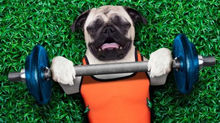So... What Am I Doing Here?
- Noah Ray Sundell
- Dec 29, 2017
- 5 min read

Congratulations! You've just joined a new gym. The treadmills are packed, the staff is smiling, and you are filled to the brim with a new sense of motivation. I hope you give yourself credit for taking this step and not being stuck in the "contemplation" stage. Now begs the question... what in the world do you do in here? Most people will begin with the most standard piece of gym equipment, the tried and true treadmill. While not a bad option, it may not be the best one - and you're not here to waste time. So let's see where you fit in this picture.
STOP! You need a goal. Going to the gym without a goal is not unlike going to school without a major in mind. You're going to waste time, resources, and it's going to be frustrating. To set goals effectively, use the SMART format. S - Specific. [Instead of "I want to lose weight", go with "I want to lose 20 pounds."] M - Measurable. [Do you have equipment available to you to measure weight/body fat consistently?] A - Attainable [Is this goal in your power to achieve?]
R - Realistic [Is it a safe and effective goal?] T - Time Bound [Hold yourself accountable with a set time frame] Examples of SMART goals: 1) I'm going to lose 5% body fat in six months. 2) I am going to eat two servings of vegetables with every meal for two months. Examples of goals that need reviewing: 1) I'm going to lose 30 pounds in one month. [For most people, this is an unsafe number] 2) I am going to lose 0.5% body fat every two weeks. [Most people don't have access to accurate body fat measurement tools] Once you have a goal in mind, you're ready to start looking into what kinds of equipment and exercises you should be doing. More often than not, I hear goals related to weight loss. Let's tackle that first. Read further if you would like to add more mass. Weight Loss Cardiovascular activities are your new best friend. The bad news is that no one likes cardio. The good news is that you have two options to get it done, you just need to weigh the pros and cons. As for frequency, you can do cardio up to six days per week. Keep in mind that to lose one pound in a week, you need to lose 3,500 calories - that amounts to a 500 calorie deficit per day. Nutrition is just as important in weight loss as your exercises. Make your effort in the gym count, and get your diet in check. Route 1: Steady-state Steady state is the most standard choice. Treadmills, ellipticals, and bikes are all examples of this. The big pros in favor of steady state are: safety, ease, and simplicity. Practically anyone can walk into a gym, hop on a treadmill and press "quick start". This option is absolutely recommended for people with mobility issues (start on a bike if this is true for you). You won't burn as many calories as quickly here as compared to HIIT, but if you don't mind spending extra time, go ahead and stick with steady-state. In summary, do this if you: - Have mobility / joint / health issues - Are an active ager - Are new to exercise - Value safety and ease over time spent Route 2: HIIT This stands for High Intensity Interval Training. As the name might suggest, this is a bit more bang for your buck. This style of training is very time-specific, and has varying work-to-rest ratios. People who do HIIT generally value their time over all, and certainly don't mind working to the point of exhaustion. Because there is little rest time and rapid, difficult movements, this is generally adopted by more experienced exercisers. There are many types of HIIT - one popular type is Tabata, which has a twenty second work to ten second rest ratio, and generally rounds of this last for around 8 minutes. In summary, do this if you: - Have a very busy schedule - Have little to no joint / health issues - Don't mind working at 80-100% capacity Weight Gain Whether you're underweight from a recent lapse in good health, or would like to get a more muscular/toned look, gaining will be done with weight resistance. Lifting weights is a little less straightforward than cardio exercises, and that complication comes in with the planning that is involved. In order to gain one pound in a week, you need to add 2,500 calories - that amounts to a 300 - 400 calorie surplus per day. As with weight loss, your nutrition here plays a crucial role - make sure you address this!
A good trainer will be able to help you with program planning (this is one of my specialties at ReFORM Fitness), it can be a little tricky. The general rule of thumb here is to train each muscle group at least once per week, and leave 48 hours minimum before training the same muscle group again. You should be lifting to exhaustion at the end of each set, to ensure that your muscle fibers are all stimulated. Try for three to four exercises per muscle group, with a higher rep range (10-12 for example) for toning, or a lower range (6-8) for strength - again, with as much weight as you can handle for that rep range. I'm going to take a guess and say that you've been told that either free weights or machines are better for muscle size. The real answer is that, like most things, it depends. A good mix of all modalities is generally the way to go. Use machines: - For isolation / smaller muscle groups
- If you have joint issues - If you have trouble "feeling" muscles as they work
Use cables: - For more complex / creative exercises - For slightly more stability than free weights - For variety in grip positions Use free weights:
- To effectively work big muscle groups - For recruiting smaller, stabilizer muscles - To create more functional movements I hope you have taken the time to feel proud of yourself for making the potentially life-changing decision of regular exercise. Whatever your goal is, know that doing things correctly takes time and there are no shortcuts. However, because of this, your results should fill you with pride and a sense of accomplishment. Be patient with yourself, and recruit a friend or family member to hold you accountable. Now go get to work!


















Comments